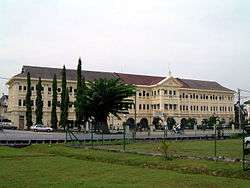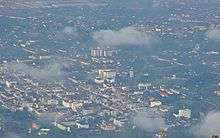Taiping, Perak
Taiping (Malay pronunciation: /taipeŋ/; Jawi: تاءيڤيڠ)(Chinese: 太平; Chinese pronunciation: /tʰaɪ̯⁵¹piŋ/; Hokkien: Thài-pêng; Tamil: தைப்பிங்) is a town located in Larut, Matang and Selama District, Perak, Malaysia. It is located approximately 48 km (30 mi) northwest of Ipoh, the capital of Perak, and 78 km (48 mi) southeast of George Town, Penang. With a population of 245,182 (in 2013),[2] it is the second largest town in Perak after Ipoh, the state capital.
Taiping | |
|---|---|
City | |
| Bandar Taiping Taiping Town | |
| Other transcription(s) | |
| • Malay | تاءيڤيڠ (Jawi) |
| • Chinese | 太平 Thài-pêng (Hokkien Tâi-lô) |
| • Tamil | தைப்பிங் |
 Kota Road at night | |
 Flag  Seal | |
| Nickname(s): The Rain Town, The Heritage Town | |
| Motto(s): | |
 Taiping  Taiping | |
| Coordinates: 4°51′N 100°44′E | |
| Country | Malaysia |
| State | Perak |
| Languages | Malaysian (including Northern Malay and Perak Malay dialects), English, Mandarin, Hokkien, Tamil |
| Established | 1874 |
| Government | |
| • Type | Municipality |
| • District Officer | Encik Mohamed Akmal Bin Dahalan |
| • Prseident of Taiping Municipal Council | Encik Khairul Amir Bin Mohamad Zubir, AMP |
| • Member of Parliament | YB Teh Kok Lim (PH-DAP) |
| Area | |
| • Total | 186.46 km2 (71.99 sq mi) |
| Population (2013) | |
| • Total | 245,182 |
| • Density | 1,315/km2 (3,406/sq mi) |
| Time zone | UTC+8 (MST) |
| Postal code | 34xxx |
| Area code(s) | 05 |
| Website | www.mptaiping.gov.my |
Taiping took over Kuala Kangsar's role as the state capital from 1876 to 1937, but was then replaced by Ipoh.[3] Its growth slowed after that, but in recent years the town has been developing rapidly again. Perak State Museum is located in the town.
Taiping also receives some limelight for being the wettest town in Peninsular Malaysia.[4] The average annual rainfall is about 4,000mm in Taiping while the peninsula's average is 2,000mm – 2,500mm. Its unusual rainfall has also led to a fertile collection of flora and century-old rain trees in the Taiping Lake Gardens.
Taiping was ranked Top 3 Sustainable Cities in the world.[5]
History
The area developed quickly in the 19th century when tin was discovered. The mines attracted large numbers of settlers, particularly Chinese. Feuds began between the different groups of Chinese immigrants and became so bitter that in the early 1870s, the British intervened and assumed control of the town.[6] Taiping was the capital for the districts of Larut, Matang and Selama in Perak. Before 1937, Taiping was the capital of the state of Perak and the centre of a long and drawn out war resulting in a change of rulership for the state. Taiping used to be known as Klian Pauh – Klian meaning mine while Pauh is a type of small mango.

Long Jaafar has been historically credited with the discovery of tin in Larut in 1848. According to legend, Long Jaafar had an elephant named Larut and he used to take this elephant with him when journeying between Bukit Gantang and Lubok Merbau. One day the elephant went missing and when the elephant was eventually found three days later Long Jaafar noticed tin ore embedded in the mud that was on the elephant's legs. It is said that this was how Larut got its name.
Eventually in 1850, Larut district was bestowed upon Long Jaafar by Raja Muda Ngah Ali and the Chiefs of Perak: the Temenggong, Panglima Bukit Gantang, Panglima Kinta, Syahbandar and Seri Adika Raja. Some time later, the Sultan of Perak, Sultan Abdullah, died in 1857 and a series of succession disputes ensued. Unhappy with the abuse and favouritism of various royalties, rival Malay camps took sides with one or the other of the two great Chinese secret societies present in there at the time.
Long Jaafar established and developed his administrative centre at Bukit Gantang and made Kuala Sungai Limau at Trong the principal harbour of the Larut Settlement. In 1857 Long Jaafar was succeeded by his son Ngah Ibrahim. Sultan Jaffar Muazzam Shah presented an acknowledgement letter to Ngah Ibrahim on 24 May 1858. This letter was signed by Sultan Jaffar, Raja Muda Ngah Ali and the Raja Bendahara of Perak. In the time of Ngah Ibrahim the Chinese increased in number and by early 1860 two large groups were formed by the Chinese, the "Five Associations" whose members worked in the mines of Klian Pauh and the "Four Associations" whose members worked in the mines of Klian Baharu.
Mining rights were given to the Hakka "Five Associations" or Go-Kuan (五館 or 五群) and the Cantonese "Four Associations" or Si-Kuan (四館). Chung Keng Quee (鄭景貴) was leader of the Hakka Go-Kuan and the Hai San (海山) society that they belonged to, and began to operate his tin mines in Larut in 1860. Larut was destined to be plagued by four major wars between members of both the Cantonese Go-Kuan Ghee Hin Society (義興私會黨) and the Hakka Hai San society. Many Hakka had fled China when the Taiping Rebellion broke out there and found work in the mines of Chung Keng Quee establishing his position over the mining area in Larut as leader of the Hai San from 1860 to 1884.
The capital of Perak was moved from Bandar Baru (New Town) to Taiping after Datok Maharaja Lela assassinated the first British Resident of Perak Mr. James Wheeler Woodford Birch at Pasir Salak in 1875. In 1937, the capital of Perak was moved from Taiping to Ipoh.
The town's mining industry continued to thrive; the country's first railway was built to transport tin from Taiping to Port Weld (now known as Kuala Sepetang) at the coast for export. The first train in Malaysia took its schedule on 1 June 1885.[7]
By 1900, an English language school,[8] a newspaper,[9] and the Perak Museum (the oldest in Malaysia) had been established.[10]
Although Taiping's economy declined with the dwindling tin deposits, tin mining still remains an important industry in the area as rubber and rice.
Geography and climate


Taiping lies 23m above sea level situated on a plain to the west of the Bintang Mountains. Perak's capital city, Ipoh, is approximately 48 km (30 mi) southeast of the town, while George Town, the capital city of the neighbouring state of Penang, lies 78 km (48 mi) away to the northwest.
Climate
Taiping also receives some limelight for being the wettest town in Peninsular Malaysia even on the driest month which is in June with 159 mm | 6.3 inch of rainfall. The average annual rainfall is about 3,000mm in Taiping while the peninsula's average is 2,000mm – 2,500mm. Its unusual rainfall has also led to a fertile collection of flora and century-old rain trees in the Taiping Lake Gardens.
| Climate data for Taiping, Malaysia (1982 - 2012) | |||||||||||||
|---|---|---|---|---|---|---|---|---|---|---|---|---|---|
| Month | Jan | Feb | Mar | Apr | May | Jun | Jul | Aug | Sep | Oct | Nov | Dec | Year |
| Average high °C (°F) | 32.1 (89.8) |
32.4 (90.3) |
32.9 (91.2) |
32.7 (90.9) |
32.9 (91.2) |
33.0 (91.4) |
32.8 (91.0) |
32.8 (91.0) |
32.2 (90.0) |
32.0 (89.6) |
31.8 (89.2) |
31.9 (89.4) |
32.5 (90.4) |
| Average low °C (°F) | 21.4 (70.5) |
22.1 (71.8) |
22.5 (72.5) |
22.9 (73.2) |
23.1 (73.6) |
22.6 (72.7) |
22.3 (72.1) |
22.2 (72.0) |
22.3 (72.1) |
22.2 (72.0) |
22.0 (71.6) |
21.6 (70.9) |
22.3 (72.1) |
| Average precipitation mm (inches) | 203 (8.0) |
222 (8.7) |
293 (11.5) |
363 (14.3) |
280 (11.0) |
159 (6.3) |
188 (7.4) |
202 (8.0) |
267 (10.5) |
386 (15.2) |
354 (13.9) |
270 (10.6) |
3,187 (125.4) |
| Source: climate-data.org[11] | |||||||||||||
Government

The Taiping Municipal Council is the municipal council which administers the township. This council was established after the township on 1930. Their jurisdiction covers an area of 186.46 square kilometres.[12]
Due to electoral division by Election Commission of Malaysia, there are two parliamentary and six state constituencies (DUN) dividing the township. There are Taiping parliamentary seat, Aulong, Pokok Assam and Kamunting state seat meanwhile for Bukit Gantang parliamentary seat, Terong, Kuala Sepetang and Changkat Jering state seat.
Education
Primary and secondary education in Taiping are provided by national-type schools, Chinese-medium schools and Tamil-medium schools.
Attractions

- Lake Garden – The first public garden established during the British rule in Malaysia. It was originally a mining ground before established as a public garden in 1880.
- Maxwell Hill (Bukit Larut) – A hill station with an altitude of about 1000m; ideal for jungle-trekking and camping.
- Tulip Garden – Located at Bukit Larut, it is the first tulip farm established in Malaysia.
- Taiping Zoo and Night Safari Taiping – First zoo to be established in Malaysia; popular on weekends with day-trippers from out of town
- Old Clock Tower
- Perak Museum - First and oldest museum in Malaysia, established since 1886 by Sir Hugh Low.
Notable people
- Anwar Fazal, Born in Sungei Bayor (Selama) but resided in Taiping. Anwar is the founder and also Chairman of the Taiping Peace Initiative and various non-governmental organisations in Malaysia.
- Felix Iruthayanathan, Former owner of company Technoprofit and first introduced WiFi calls to British company EE Limited
- Imee Ooi, music producer, composer, arranger and vocalist.
- Lim Swee Aun, Former Health Minister of Malaysia.
- Uthaya Sankar SB, a Malaysian writer from Aulong Lama, Taiping.
- Toh Chin Chye A Singaporean politician who served as the Deputy Prime Minister for Singapore.
Transportation
Rail
The Taiping railway station was the first operational train station in Malaysia. Originally, the station served the local tin mines, transporting ore to Port Weld (now Kuala Sepetang) and mine workers to workers settlements. In the 1930s, railway connections to other towns like Ipoh, Kuala Lumpur, and Singapore started. The Taiping-Port Weld line was dismantled by KTMB in the 1980s.[13][14]
The station was previously served only by KTM Intercity trains, with a one way trip to KL Sentral taking about six hours. Since 1 July 2015 however, the station has also been served by KTM ETS's ETS Ekspres service, reducing the travel time on the same route to about three hours. In addition, Taiping also serves as a stop on the ETS Transit service between Ipoh and Padang Besar.
References
- http://www.mptaiping.gov.my/ms/mpp/profil/logo
- Senarai Mukim dan Statistik Penduduk
- Malaysian States http://www.worldstatesmen.org/Malay_states.htm
- Newspapers recorded Taiping as the wettest place in Malaya in March 1937, with a rainfall of 21.55 inches, and Maxwell's Hill next to it with 16.01 inches. Comparatively, Kuala Lumpur's rainfall was just 6.39 inches (The Straits Times, 24 April 1937, Page 12).; In 1959, The Straits Times (The Straits Times, 2 April 1959, Page 7) reported, 'Water was rationed 39 days last year in Taiping, the wettest town in Malaya. 'Taiping's Larut Hills record the highest annual average total of 5800 mm rain (Cranbrook, Gathorne Gathorne-Hardy, ed. Malaysia:key Environments. Oxford: Published in Collaboration with the International Union for Conservation of Nature and Natural Resources by Pergamon, 1988. Print. Page 7).
- "Asia University Rankings 2018". The Star Online. Retrieved 7 March 2019.
- See pages 86–88, Chapter 8 Malaysian Confrontations, Send A Gunboat: The Victorian Navy and Supremacy at Sea, 1854–1904, by Antony Preston & John Major, Conway, an imprint of Anova Books Ltd, London, UK, 2007 Revised Edition, ISBN 978-0-85177-923-2
- The Straits Times, 31 August 1931, Page 6
- Straits Times Weekly Issue, 12 November 1890, Page 3
- The Singapore Free Press and Mercantile Advertiser (1884–1942), 28 April 1894, Page 11
- The Straits Times, 6 March 1889, Page 2
- "Climate: Taiping, Malaysia", climate-data.org 2016. Web: .
- http://www.mptaiping.gov.my/en/mpp/profile/background
- "Landasan Keretapi Yang Pertama di Tanah Melayu". Archived from the original on 23 April 2009. Retrieved 1 December 2009.
- Malayan Railways 100 years 1885 – 1995
External links
| Wikivoyage has a travel guide for Taiping. |
![]()